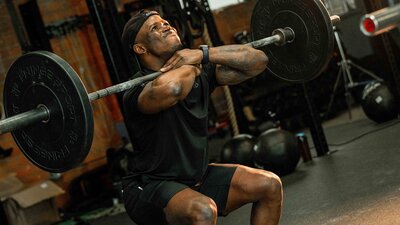You get to the gym and scan the equipment. You didn’t come with a plan, but that won’t slow you down. Getting in a great workout isn’t always about following a program. Rather, it’s about structuring a smart training split and giving it your all. Find out how to plan the perfect training program on the fly.
Warm up
In order to gain muscle effectively, it all starts with a solid warmup. Now, how you get this warmup in will depend on what you’re training. If you’re focusing on just upper body or lower body or some specific body parts, then you’re going to want to hone in on moving those specific muscle groups. If however, you’re doing a full body workout, then some full body movement is in order. Either way, including some dynamic stretches or bodyweight workouts will really work to get your blood flowing and prevent injuries. Performing some bodyweight lunges before a big deadlift or some band work before some bench press can really help to get your body firing the way it needs to.
Training goals
Like we alluded to in the previous section, knowing what muscle groups you want to target is going to be of utmost importance when coming up with your workout plan. Knowing which muscles to pair together provides the framework for whatever workout routine you’re going to develop. Get clear and specific, taking inspiration from popular pairings (such as chest with triceps) and the rest of your workout will fall into place. Keep in mind too whether you’re wanting to train more for hypertrophy or if you’re wanting to follow more of a strength training route. This will allow you a better idea of what types of exercises to focus on and what sorts of rep schemes would be best to implement. As a general rule, you’re going to want lower repetitions and higher intensity if strength is your goal. On the other hand, you’ll want more of an emphasis on mind muscle connection and more repetitions if muscle growth is your primary concern.
Compound Exercises
Now one of the major ways to structure a solid workout program is to begin with compound exercises. Compound lifts are exercises that have movement over more than one joint, which involves multiple major muscle groups. Doing so allows you to really stress large swaths of muscle with heavier weight, which is great for building strength as well. The reason we advocate for these types of lifts first is so that you don’t end up bottlenecking your performance by tiring out smaller muscles earlier. If you had done lateral raises before your bench press, then your deltoids would be too tired to continue while your chest still had more to give. This would lead to inadequately working the chest and weaker performance in terms of bench press strength. Avoid this common pitfall and start strong with the compound lifts. Major compound lifts are those of the aforementioned bench press (barbell or dumbbell variation), deadlift, back squat, front squat, overhead press, leg press, bent over row, pull up, and push up. Let compound lifts become your foundation, so you can build a solid workout effectively from there.
Isolation Exercises
Maximizing muscle mass continues past these major compound movers into the smaller isolation exercises. These get their name because they typically isolate just one muscle group. They involve movement over only one joint, and as such, they provide a much more controlled emphasis. When people think of bodybuilding, they usually imagine bicep curls and the like. This is because these types of workouts are great for building mind muscle connection, allowing focused attention on getting the most strain on a singular muscle. Try to feel every bit of the muscle work on these lifts. The most common effective isolation exercises are bicep curls, tricep push downs, incline dumbbell flys hamstring curls, leg extensions, and calf raises.
These can even be spiced up with supersets and drop sets to really stress your muscles. These single joint exercises are going to be best for squeezing the last bit of energy from your body, helping to round off the best workout we can achieve.
Getting it Done
Creating your own workout on the fly is not an unachievable order. It all just comes down to creating an overarching organizational structure to your lifts and giving each exercise your all. Make sure to vary up your training between days and stay consistent, employing progressive overload in your work. With these principles in mind, you’ll be sure to craft the training routine that works best for you.

